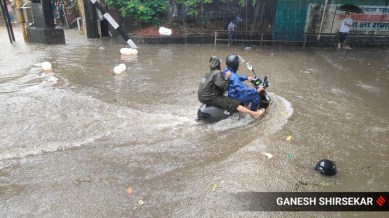Stay updated with the latest - Click here to follow us on Instagram
From sponge park to bioswale, Mumbai civic body proposes Rs 12,000 crore plan to combat flooding
BMC's blueprint aims to re-engineer the city’s aging drainage infrastructure and enhance its climate resilience

In a bid to shield Mumbai from its growing monsoon woes, the Brihanmumbai Municipal Corporation (BMC) has submitted a proposal to the National Disaster Management Authority (NDMA), outlining 26 flood mitigation measures worth Rs 12,705 crore.
From sponge parks and bioswales to advanced detention and filtration systems, the civic body’s blueprint aims to re-engineer the city’s aging drainage infrastructure and enhance its climate resilience.
The move comes as Mumbai continues to grapple with increasingly severe rainfall. According to BMC data, the city has seen a sharp rise in downpours with the average very heavy rainfall within a 24-hour period climbing from 132 mm to 182 mm over the past six years. This surge in precipitation has led to frequent flash floods, disrupting life and transport across the city. Between March and August this year alone, Mumbai was repeatedly brought to a halt due to relentless rain.
On August 26, a delegation of BMC officials met with NDMA representatives to present the detailed proposal and formally request central funding for the execution of the planned interventions.
What does the BMC propose?
According to the civic body sources, out of the 26 interventions that have been proposed, 22 are structural interventions, while four are non-structural interventions. Structural interventions refer to projects that will be built from scratch and will require heavy lifting of civil works. Meanwhile, non-structural interventions involve upgrading existing infrastructure or implementation of cost effective measures.
According to the BMC’s plan, some of the popular structural interventions the BMC aims to implement include construction of a sponge park for Rs 200 crore, creation of bio-swale at Rs 100 crore, setting up of sluice gates at Rs 2,000 crore, construction of permeable pavements at Rs 120 crore, as well as construction of pumping stations at Rs 700 crore.
A bioswale is a vegetated depression that functions as a natural filter for stormwater runoff, capturing, treating and infiltrating rainwater from urban areas. Similarly, a sponge park is an engineered urban wetland designed to absorb and release rainwater in a slower manner. Sluice gates are vertical gates that controls the inflow and outflow of water during the period of high tides. Since Mumbai is an island city, these gates will play a key role in controlling the tidal movement of water.
“Slow rainfall creates maximum percolation, but high rainfall doesn’t allow smooth percolation of water because the surface of Mumbai has become so impervious with time that the accumulated rain water that doesn’t percolate get accumulated on the surface and create water logging. Therefore, our target is to increase Mumbai’s percolation capacity,” a senior officer privy to this development told The Indian Express.
“Creation of bioswales and sponge parks are cost effective measures. Once they become operational, the percolation capacity of Mumbai’s surface will increase. Even, if we are able to increase the percolation by 10 per cent, then it will reduce the overall waterlogging in Mumbai by a significant margin,” the official added.
Out of the four non-structural interventions that have been proposed – the BMC has focused on setting up an ambitious early flood warning monitoring system and a cloud burst monitoring system at a cost of Rs 300 crore. The civic authorities stated that this system will comprise, sensors, drones as well as decentralised control systems.
“The idea behind setting up such a facility is to have an advanced warning system equipped with sensors. Mumbai records erratic rainfall pattern leaving the city to a prolonged risk of cloud bursts. This system will help us determine the possibility of cloud bursts at an early stage so that the mitigation approaches could be strengthened in advance. Being a coastal city Mumbai witnesses high tide regularly, therefore it js important to have these kinds of sensors in place,” an officer said.
The officials said that as part of the early warning system sensors will be set up in some of the sensitive zones upon consulting the weather bureau. Following this, command and control systems at the municipal ward levels will also be set up for concrete management.
Besides these interventions, the BMC has also proposed a massive project of augmenting the storm water drain (SWD) network for Rs 2,000 crore, and plans to interlink the existing water bodies like canals and lakes in the city at a cost of Rs 980 crore. The officers said that linking the water bodies will create an automatic path for accumulated rain water to flow without causing inundation at residential areas.
First step, carry out an overall hydrological study of Mumbai
Civic body officers said that following the presentation, the NDMA in its meeting has expressed some queries with the BMC’s plan.
“The presentation was fruitful and after we send our replies the NDMA will forward the proposal to the Ministry of Home Affairs, which is expected to give us the final clearance. Once the clearance comes through, the project costs will be reevaluated and tenders will be floated,” an officer privy to these developments told The Indian Express.
“The first step of implementing this project is to carry out an overall hydrological study of Mumbai. This will allow us to identify the risk prone areas at the earliest as well as identify the flow of accumulated rainwater and the nature of percolation. We will be roping in expert agencies like the Indian Institute of Technology (IIT) and Veermata Jijabai Technological Institute (VJTI) for implementation of this project as well,” the official added.